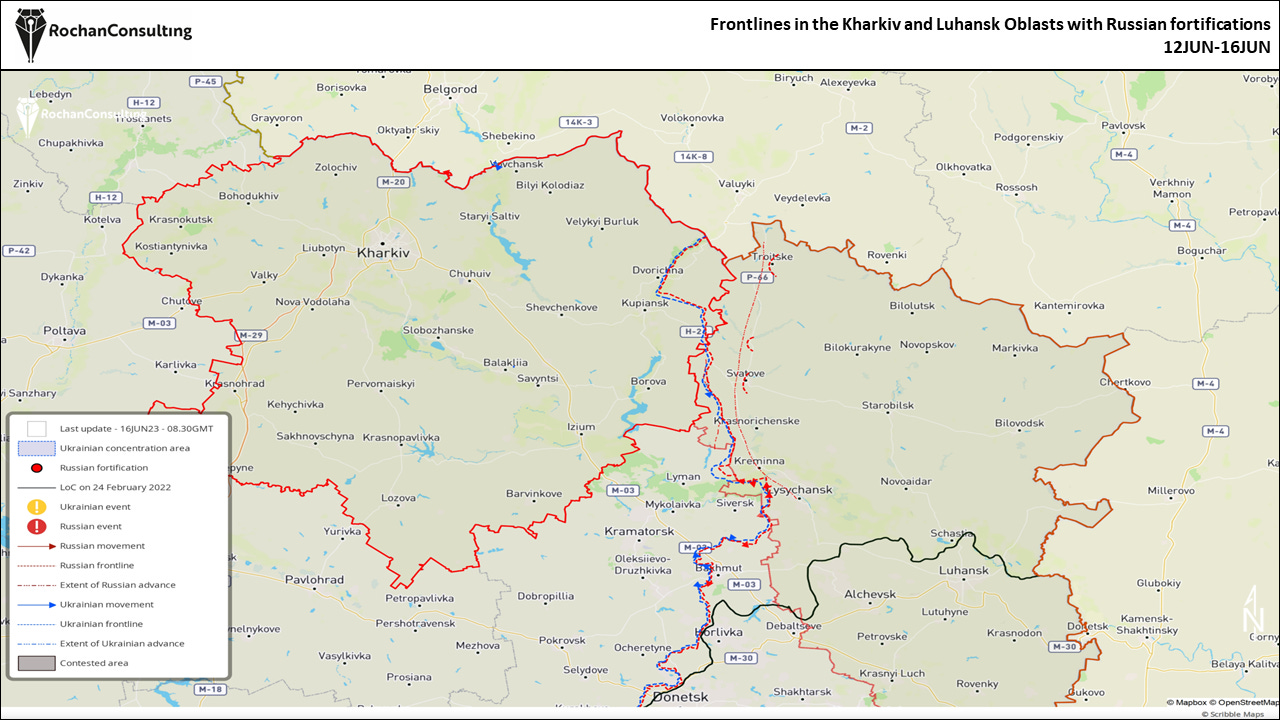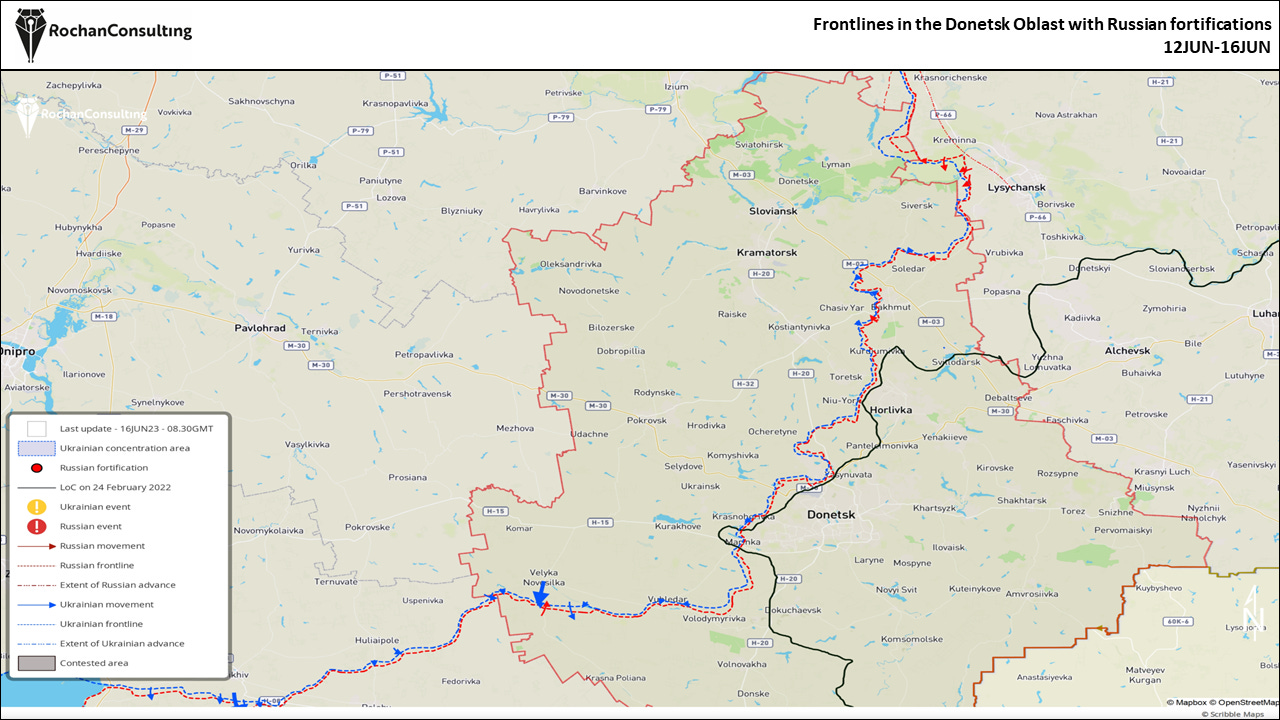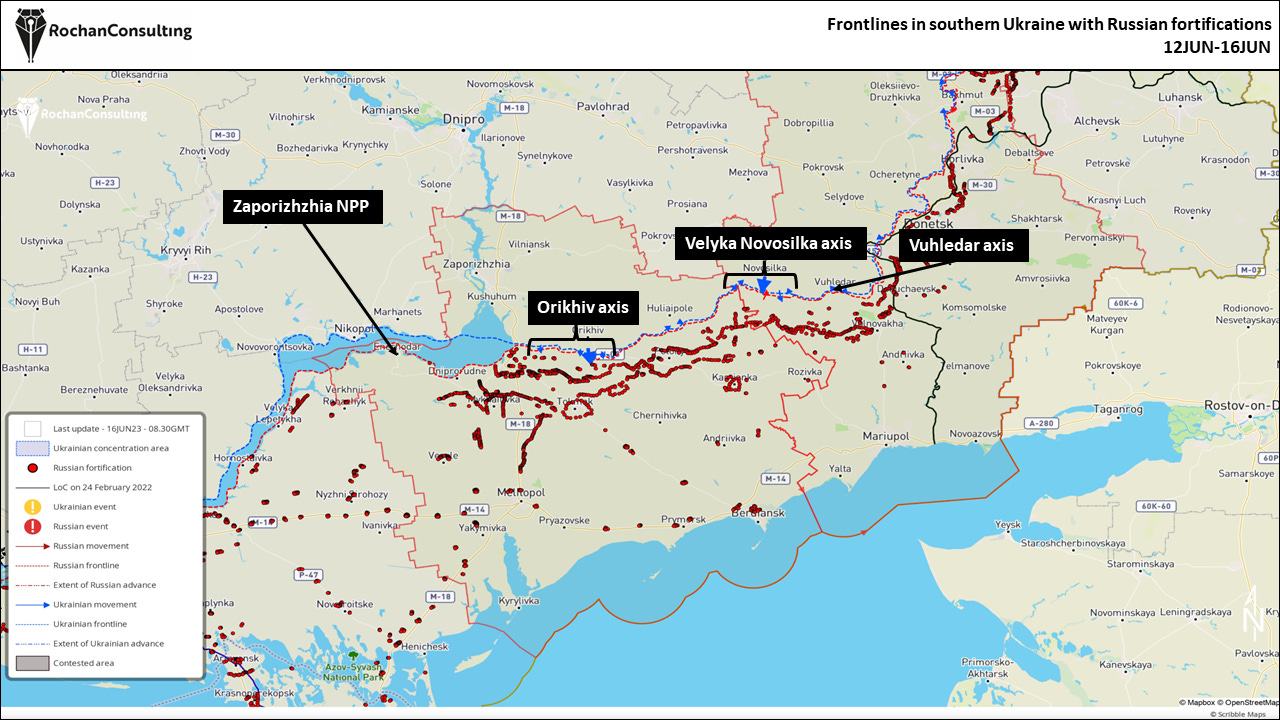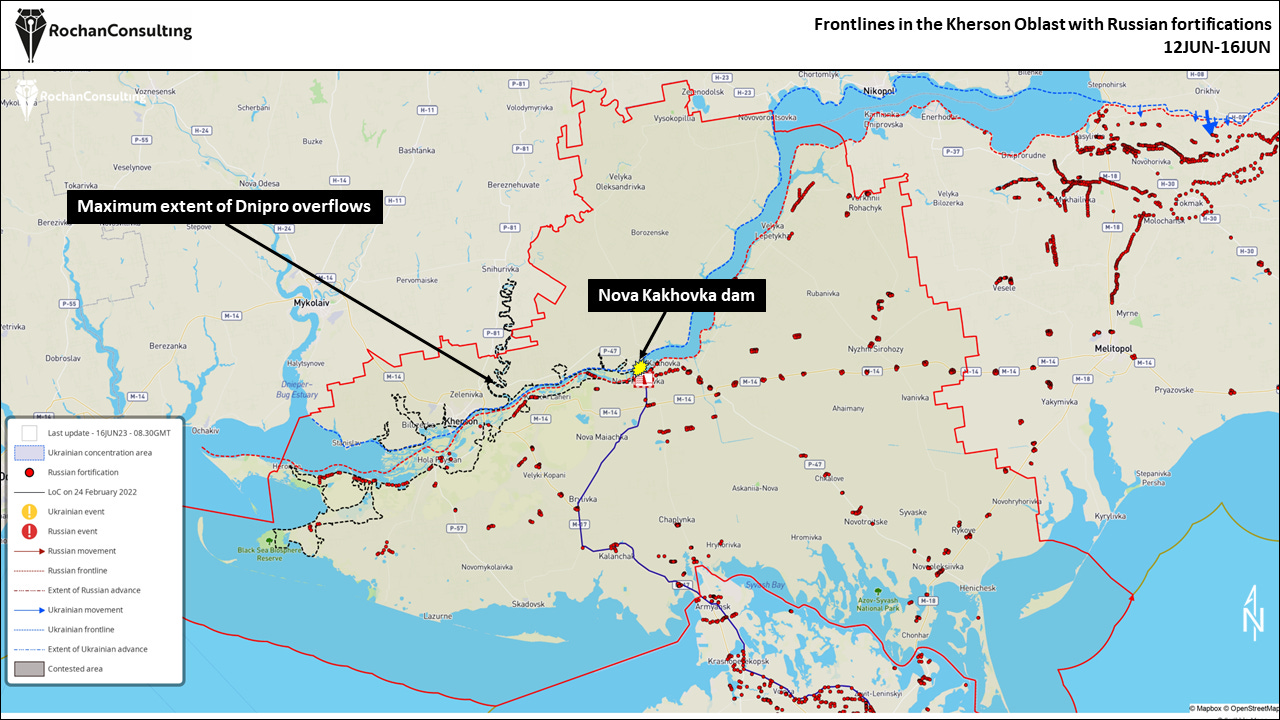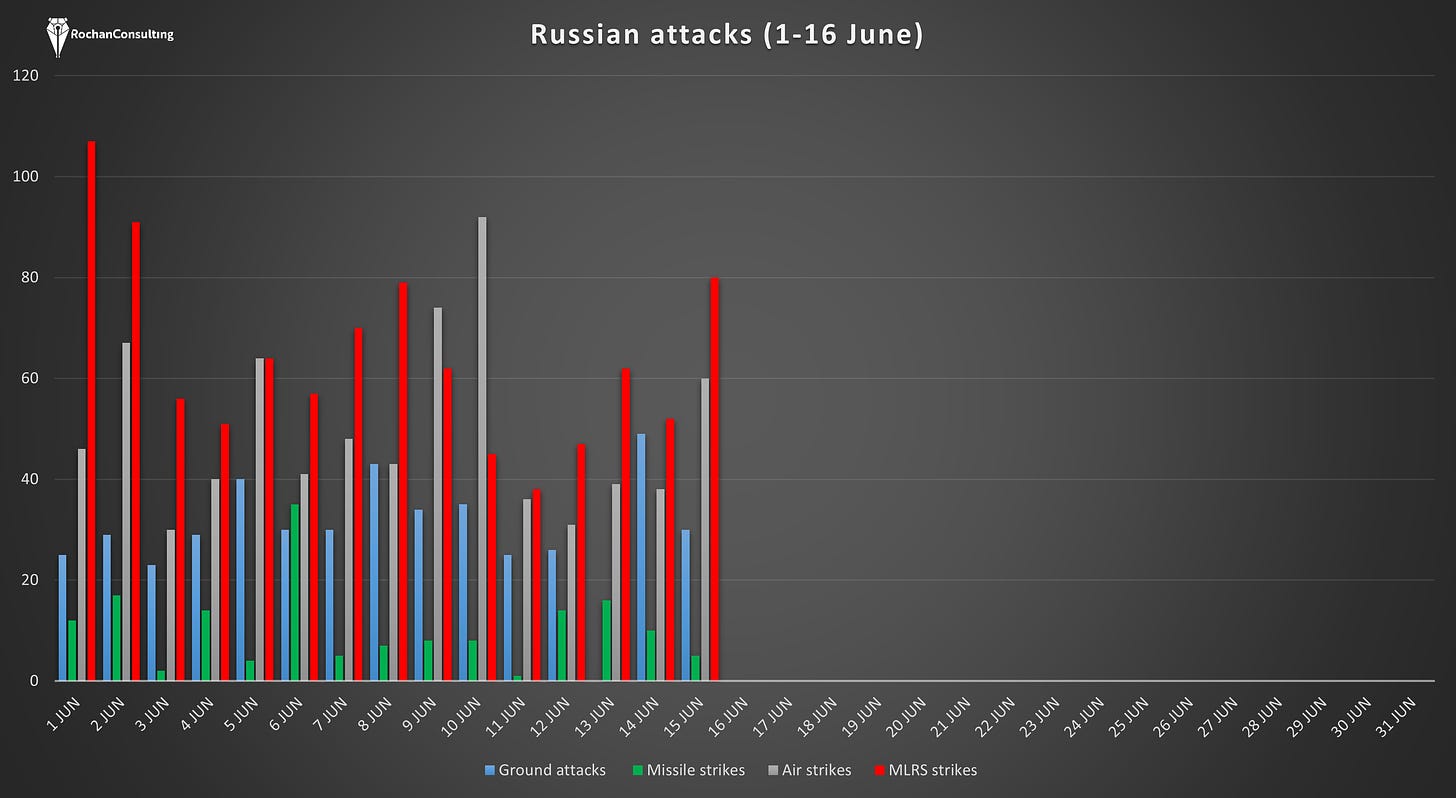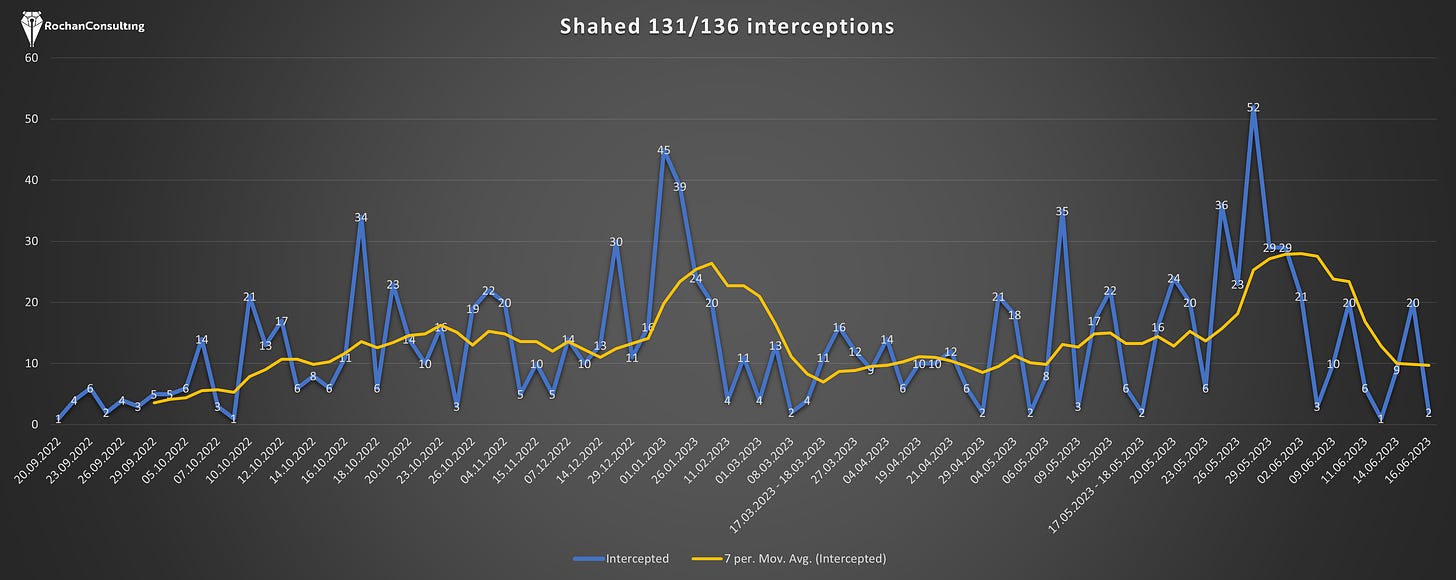Ukraine Conflict Monitor - 12 June - 16 June 2023 (Weekly update)
Situational report 12 June – 16 June 2023
**From now on, Belarus updates will no longer be published within UCM. Instead, they will be released separately on Monday. We will revert this change should Belarus enter the war**
Key takeaways from last week’s developments:
The main phase of the Ukrainian counteroffensive continued, but Ukrainian gains proved to be limited; The number of newly established Ukrainian brigades committed to battle did not change; In fact, it may have decreased following the withdrawal of the badly battered Bradley- and Leopard-equipped 47th Mechanised Brigade; This decision also highlights a lack of stubbornness in conducting pointless assaults, which Russian commanders showed during the assault on Vuhledar in JAN-FEB2023;
Ukrainian force commitments are greater in the Velyka Novosilka, where Kyiv maintained nine brigades, including two artillery; In recent days, Ukrainians launched some successful artillery strikes on Russian artillery and air defence assets to hinder Moscow’s fire support capability in preparation for the deployment of more into the battle; Altogether, Ukrainians liberated some 100 sq km since mid-last week;
The overall situation in the Kharkiv Oblast did not change; Russians made no territorial gains, while the Russian Volunteer Corps continued to maintain some presence in the Belgorod Oblast;
The frontline in the Luhansk Oblast did not change either; however, the most recent reports indicate Russian determination to capture Bilohorivka;
No significant frontline changes were reported in the Donetsk Oblast (apart from the Vuhledar axis);
Ukrainian units carried on counterattacks on Bakhmut’s flanks, but despite official announcements claiming progress, no visual evidence was presented to confirm territorial gains;
The Vuhledar axis remained stable for most of the week; however, late in the week, Ukrainian sources claimed progress in this area;
The Dipro flows appeared to have stabilised, although many areas are still flooded; Ukrainians have reportedly launched two cross-river attacks near Hola Prystan and Nova Khakovka; both were repelled;
Russian missile and drone attacks were limited last week and delivered no impact on the battlefield; One cruise missile hit a residential area in Kryvyi Rih, killing at least 11 people;
Executive summary
The past five days did not deliver any major frontline changes. Ukrainians continued counterattacks near Orichiv, Velyka Novosilka, Vuhledar and Bakhmut, but the impact on a frontline was relatively limited.
Ukrainians made the biggest progress near Velyka Novosilka, where they deployed seven manoeuvre units and two artillery brigades to provide fire support. It seems that territorial gains came as a result of a momentum built up during the initial days of the counterattack. Without the deployment of reinforcements, momentum petered out early this week, and by Friday, Russians conducted numerous counterattacks on this axis, trying to regain their losses. All Russian attacks appear to have been repelled.
The kill zone Ukrainians entered south of Orichiv, which comprised ATGM crews, artillery, minefields, and aviation, also stopped Kyiv’s advances as the Bradkey- and Leopard-equipped 47th Mechanised Brigades suffered losses and was pulled back. But at the same time, there is a striking difference in the number of units committed to both axes. In the latter axis, Ukrainians employed only five brigades supported by one artillery brigade, a force 50% smaller than what was sent to battle Velyka Novosilka.
The Ukrainian centre of gravity thus is around Velyka Novosilka, and currently, the prospects of Ukrainian success are the biggest there. It does not mean the main Ukrainian push is ongoing on this axis. The commitment of newly established brigades is still relatively low, and Ukrainians still have ample reserves to be sent to combat.
But to sum up the first week, Ukrainian artillery preparations were insufficient to disorganise Russia’s defence and disrupt its C2, especially along the main axes of advance. This especially pertains to the elimination of Russian ATGM capability and artillery assets.
Neither did Ukrainians manage to sufficiently surveil Russian minefields and other engineering fortifications even close to the FLET (forward line of enemy troops). This, combined with an insufficient number of sapper units deployed, resulted in a small assault tempo, high losses, and limited gains, especially near Orichiv.
Nevertheless, the past few days have seen Ukrainians focus on operations to degrade Russian artillery support. Only within a day, Russians lost five 2S19 Msta-S self-propelled howitzers. Ukrainians also hit air defence and electronic warfare equipment to open up the skies for its own aircraft, limit Russia’s ability to operate freely closer to the front, increase the accuracy of precision-guided munitions, and improve its own C4.
On both axes, Ukrainians are still some 8-10 kilometres from the first major Russian defensive lines.
The West continues to deliver equipment. This week images surfaced showing Swedish-donated Strf9040C (also known as CV90) IFVs in Ukraine. Indeed, the Swedish Armed Forces press service stated on 8JUN that Ukrainians had finished their training and that 50 vehicles would soon be transferred to the country. It is unclear which unit operates CV90s, but the impact on the firepower of frontline formations and crew survivability will be evident. The United States government also announced the delivery of an additional 15 M2A2 Braldeys and 10 Strykers to Ukraine, partly to cover the losses sustained last week.
Although the decision to donate F-16s to Ukraine has not yet been (officially made), Jens Stoltenberg, Secretary General of NATO, stated that Ukrainian pilots were being trained to fly these fourth-generation fighter aircraft. Although this is a speculative comment, training would not have started had the likelihood of delivering F-16s to Ukraine been small.
We have seen various comparisons floating around about the ongoing counteroffensive. The reality is that what is presently occurring is neither akin to the Kherson Offensive nor what happened in Kharkiv. The Kharkiv Oblast was deprived of regular Russian army formations, which made it easier to advance once Ukrainians pierced through initial defensive lines. In the Kherson Oblast, thanks to HIMARS strikes on the Antonovsky Bridge and other river crossings, Ukrainians could isolate the battlefield north of the Dnipro River, forcing Russians to abandon their positions. Yet, despite the sustained employment of high-precision capabilities, the latter campaign lasted three months.
Ukrainians cannot isolate the current battlefield in the Zaporizhihia and Donetsk Oblast, while the hundreds of kilometres of echeloned defensive lines will undoubtedly cause casualties on the attacking side. We are in the early stages of the third Ukrainian counteroffensive during this war. This one will be the most difficult and complex to undertake. It is thus important to manage one’s expectations as to how quickly and what this counteroffensive can deliver.
Ukraine battle map
Please click here to access our interactive map and click here to access the archive.
The situation at selected axes and directions
Kharkiv direction
The past week again brought no changes to the frontlines in the Kharkiv Oblast. The deprioritisation of the region continues.
No frontline changes were reported near Masiutivka, Hryanykivka and Krohmalne. We assess that the probability of Russians making any gains in the direction is currently very low and do not expect this to change until the end of June, at least.
Russians continued to conduct artillery strikes on civilian targets across the oblast. Last week, they hit Pertropavlivka, Ivashky and Kupyansk and Vilkhuvatka, Khorosheve, Shervchenkove, Vovchansk, Lyptsi and Tsyrkuny.
At the same time, there are no reports about a Ukrainian build-up in the area, as Kyiv has focused its operations in southern parts of the country.
Russians launched no ground attacks from Russia proper into the Kharkiv Oblast.
But, the Russian Volunteer Corps still maintains its presence in the southern parts of Nova Tavolzhanka. They probably control the area of a few sq kilometres. Attempts to break through Russian lines were not successful. A Russian source claimed that the Chechen Akhmat Force-West unit already started arriving in the area to improve its defence. Indeed, Adam Delimkhanov, a Member of the State Duma, said on Thursday that Chechen fighters were working near the border of the Belgorod region. Another Russian source added that a partially mobilised unit that had received extensive training was being moved to the Belhorod region. The same source also claimed that Ukrainian artillery continued to strike Russian civilian areas in Shebekino, Kazinka and other settlements in the region. On 15 JUNE, the Freedom of Russia Legion said they were preparing for new tasks but did not provide further details.
The Russian MoD claimed to have continued strikes on Ukrainian units in the Kharkiv Oblast. Specifically, the source stated that Ka-52 and Mi-28 attack helicopters hit concentration areas of the 14th Mechanised and the 103rd Territorial Defence Brigades. Su-34 fighter-bomber/strike aircraft also hit a concentration area of the 4th TDF brigade in Petropavlivka. Also, near Stelmakhivka, a Russian special-purpose reconnaissance unit (96th Separate Reconnaissance Brigade?) interdicted Ukrainian sabotage and reconnaissance unit operations.
The ministry also claimed to have disrupted three Ukrainian attempts to rotate their forces near Molchanovo(?), Novomlynsk and Kyslivka.
Luhansk direction
As expected, the situation in the Luhansk Oblast did not undergo any changes over the past week, although Russian attempts to shift the frontline continued.
It appears that the intensity of Russian artillery strikes remained relatively high. According to Serhiy Cherevaty, the Eastern Group of the Ukrainian Armed Forces spokesman, on 12 and 13JUN, in the Lyman – Kupyansk direction, Russians fired 505 and 428 times, respectively, on Ukrainian targets. The attackers launched 11 ground attacks and 17 air strikes within the same period. Ukrainians claimed to have killed 64 and wounded another 145 Russian soldiers.
According to Artem Lysohor, the Luhansk Military Administration Head, every Russian ground attack ended in failure. He added that Russians had begun to use Lancet drones in the Luhansk region more actively. That said, Ukrainian units allegedly identified the location of the mini-airfield from which Lancets were launched and destroyed it. Lysohor also claimed that in recent days, between Svatove and Starobilsk, Russians had set up ten more military hospitals. One can accommodate up to 150 soldiers.
When it comes to the frontline, neither side reported any significant developments in the Luhansk Oblast. The situation in the Svatove area remained stable, and no Russian attacks were recorded near Stelmakhivka.
No changes occurred near Novoselivske and Kuzemivka, although reports from these areas suggest that positional battles or, rather, skirmishes occurred.
The frontline remained unchanged near Makiivka, Ploshchanka and Chervonopopivka. No shifts occurred near Terny, Torske and Nevske.
When it comes to the Kreminna area, limited exchanges were reported near Dibrova and in the Serebryansky forest. Yet, despite this, no reports suggested any frontline changes.
Russian attacks on Ukrainian positions near Bilohorivka also continued. Although all were pushed back, according to Ukrainian sources, the overall situation in the area deteriorated. Russians reportedly continue to pull up reserves in the areas, which highlights the determination to capture Bilohorivka.
According to a Ukrainian journalist, the UAF struck the Russian base(?) in Luhansk. The target was unclear, but a Russian source stated that a Storm Shadow cruise missile hit a local car market area.
The Russian MoD continued to assert that its forces maintained pressure on Ukrainian units in the region. Reportedly, Russian bomber aircraft hit three deployment sites, a stronghold and an equipment concentration area in the oblast. Russian aviation and artillery struck the Ukrainian concentration sites of the 63rd and 67th Mechanised Brigades near the Torske and Serebryansky forest. It is also near the latter, where the 95th Airborne Assault Brigade and the 15th National Guard Regiment were missile-struck.
Russians also claimed to have two ammunition depots and a stronghold near Yampolivka and Nevske.
(The data on Russian fortifications comes from Brady Africk).
Donetsk Oblast Direction
Looking at the entire Donetsk Oblast, the Ukrainian side appeared to have shown more initiative last week, while Russian formations’ posture, with some exceptions, is defensive.
No changes occurred (or were reported) near Spirne, Verknohkamyanske, Ivano Darivka and Vyimka. It appears that Russians have also abandoned any plans or even efforts to try to break the deadlock in the northern Donetsk Oblast. Over the past several weeks, reports about Russian attacks in this area have substantially decreased, suggesting a lack of capacity to undertake more sizable (battalion-level and above) attacks.
The frontline also remained stable in Vasiukivka, Fedorivka, Rozdolivka, and Vesele. A Russian source claimed that with artillery support, the UAF attacked Russian positions near Andriivka, Klischiivka, Yahidne and Berkhivka. These assaults were, however, repelled.
We understand that Berkhivka remains partly under Russian control as Ukrainians lack the resources and manpower to conduct the final push to liberate the village.
Hanna Malyar, the Ukrainian Minister of Defence deputy, made numerous claims last week about the progress of Ukrainian units in various parts of the front in the Bakhmut direction. In total, she said, the UAF progressed between 650-950 meters. On Monday, she specifically stated that Ukrainians progressed 250 meters near the Berkhivsky reservoir. Despite this, and it also reinforces our point from last week, no visual evidence has been presented to confirm these gains. Despite official pronouncements alledging constant progress, we have not updated our battle map to depict these unconfirmed gains.
A Ukrainian soldier said that the UAF had become closer to the Yahidne settlement, but it is unclear what this involves.
Another serviceman stated that Moscow had moved significant PMC Veteran reserves into the Bakhmut axis, which is consistent with previous reports about the deployment of various military formations toward Bakhmut to fill in the void caused by the pullback of the Wagner PMC.
It currently seems unlikely that Ukrainians will achieve significant gains in the Bakhmut axis, especially if no additional units and equipment are deployed to reinforce existing formations.
Ukrainians maintained their positions in the southwestern parts of Bakhmut as battles continued in the Dachi area. A decreased intensity of combat in the city was confirmed by Cherevaty, who stated on Tuesday that although Russians continued to conduct artillery strikes on Ukrainian positions in the city, the number of ground assaults was visibly reduced. He added that on 12JUN, only one such assault was recorded. Cherevaty explained this decrease by the quality of Russian forces deployed to the city, which according to him, were demotivated.
Ukrainians also appeared more active in the southern flank. Battles continued to the west and northwest of Klischiivka. According to the Russian source, Ukrainian troops steadily progressed up to 100-200 metres, but the source also presented no evidence to support these claims.
Cherevaty claimed that Russian counterattacks near Bila Hora and Ivanivske were unsuccessful. Reportedly, the Russian 80th Tank Regiment (90th Tank Division, Central Military District) was spotted in this sector, but it probably does not indicate Russian willingness to conduct offensive operations.
As for Wagner, Yevhenii Prigozhin, the organisation head, claimed that his troops would return to the front on 5AUG2023. He did not specify where exactly the Wagner would reappear. There are many reasons to be inherently sceptical about Prigozhin’s claims, and we do not attach particular importance to the date he provided. In fact, given Prigozhin’s track record in making predictions, it is likely that Wagner would be deployed to combat earlier.
Neither Russian nor Ukrainian sources reported any changes near Krasnohorivka, Novokalynove, Keramik, Stepove, Berdychi, Kamyanka and Kruta Balka. According to the Ukrainian source, fighting near Vesele resumed early in the week. The source claimed that Russian attacks were repelled. It was from this area where a video allegedly showed a Ukrainian platoon from the 110th Mechanised Brigade surrender. The Ukrainian source stated that the video was fake and made by the Russians to discredit Ukrainians and their ability to fight.
No changes occurred near Avdiivka. As stated previously, Russians do not have enough resources to make any gains in the region, so all assaults are repelled. This week, they launched several artillery-supported attacks on the city’s northwestern outskirts but delivered no gains.
According to the Russian journalist, the UAF launched some assaults near Vodyane and Opytne, but they probably delivered no tangible gains. On Monday, Russians launched more aggressive attempts to capture the remaining parts of Mariinka, attacking the settlement from three directions. The attacks continued on Tuesday and Wednesday, but on Thursday, Russians reportedly achieved some tactical successes. It remained unclear what this progress involved.
According to the Ukrainian source, Russians lost ground near Pervomaiske “due to the weakening provoked by the actions in the Zaporizhzhia Oblast”, which we understand means that Russians were forced to redeploy some of their forces from this area to the Zaporizhihia to stall Ukrainian attacks there.
Russian sources did not report changes. Neither Russian nor Ukrainian sources reported changes near Tonenke, Severne, Vodyane and Nevelske.
Southern Ukraine direction
Please click here for our strategic assessment of the situation in Southern Ukraine.
Vuledar axis
The first part of the week was eventless. However, on Wednesday, the press service of the Tavriia Region stated that Ukrainian units advanced one kilometre near Vuledar (a Ukrainian soldier claimed it was more than one kilometre). The service said that since last week, Ukrainians had progressed three kilometres to the east.
It is unclear what this means. No visual evidence was published confirming Ukrainian progress, while Ukrainian bloggers show that Russian positions go as far as north of Mykilske.
Velyka Novosilka axis
After initial gains made on this axis last week, Ukrainians were faced with conducting a mix of defensive and offensive operations.
Firstly, according to the Russian source, Russian reserves were deployed to Staromlynivka, from where they were sent to defend the Urozhayne – Novodonetske – Novomayorske line. They launched counterattacks towards Blahodatne. Although the attack failed, Russia managed to level the frontline from Urozhaine to the Novodonetske. However, we understand that Ukrainians made a breakthrough attempt between these two villages and that the frontline is not exactly “levelled out” in this particular sector. The source added that although Ukrainians continued to suffer losses, Kyiv still had ample resources to commit to the battle. Russians have also augmented their forces with Strom-Z units, not only on this axis but also near Orichiv.
On Thursday, a meeting engagement occurred near Urozhaine. The source claimed that the Ukrainian troops were forced to switch from active assault actions to fighting for the initiative.
Over the past five days, Ukrainians were confirmed to have captured Novodarivka and Makarivka.
Ukrainians continue to attempt to reach Pryyutne, but they have been unsuccessful so far. Battles were ongoing north of Rivnopil, south of Makarivka, north of Urozhaine, and north of Novodonetske.
It thus appears that Ukrainians are trying to reach Staromlynivka to capture an important road junction there. Ukrainians also decided to attack not through Novodonetske but through the lowlands along the Mokryi Yaly River, although some Russian sources claimed that Ukrainians managed to capture land on high grounds, which could potentially make it easier for Ukrainians to progress. The attack along the lowlands is likely a successful Russian attempt to channel the movement of Ukrainian forces along unfavourable terrain.
Videos were posted on Wednesday reportedly showing the destruction of five Russian 2S19 Msta-S self-propelled howitzers near Yalyns’ke, some ten kilometres from the frontline. This event shows three things. Firstly, within a day, Russians lost almost the entire 2S19 battery (six vehicles), representing a major capability loss. Secondly, given that Ukrainian drones filmed the strikes, Kyiv UAVs can operate and provide targeting data behind the frontline despite Russian EW efforts to limit Ukrainian ISR means. Lastly, Ukrainians use GMLRS to conduct counterbattery fire, which can produce tangible results.
Orichiv axis
Russians deployed Storm-Z (former convicts) troops along the frontline, where they reportedly were used to stall Ukrainian attacks near Kamyanske. Another source added that the 128th Mountain Assault Brigade was being redeployed to strengthen the Ukrainian offensive potential in the Zaporizhihia Oblast.
According to the Ukrainian bloggers, the fighting continued north of Robotyne – Verbove and south of Lobkove. South of Novodanylivka, Ukrainians progressed a few hundred meters.
On Wednesday, Malyar stated that the UAF advanced from 300-350 metres in different areas in the Zaporizhzhia Oblast, which probably confirms the abovementioned gain near Novodanylivka.
Ukrainian units also attacked Russian positions near Pyatykhatky and Dorozhnyanka throughout the week, but these attempts delivered no results.
The Ukrainian objective may be to push to the junction of the M-18 and N-30 roads near Zeleni Hai and then cut off Russian forces in the Vasylivka area. This would also open up opportunities to either push towards Enerhodar or to Melitopol.
Interestingly, Russian sources claimed that Ukrainians might open up another axis near Hulyaipole. They reportedly observed the activation of Ukrainian GPS efforts to jam Russian UAVs. The source added the Ukrainians had concentred significant forces in this area. Reconnaissance groups operated around the clock while artillery struck Russian defensive lines in depth. Objectively, if such an undertaking were indeed ongoing, then a new axis would likely be opened soon.
Kherson direction and Crimea
Last week delivered no new developments in the Kherson Oblast.
Malyar stated on Monday that Russians were redeploying from the region their most combat-capable units from the 49th Combined Arms Army, naval infantry and airborne formations. She did not specify where these units were being sent to, but we assume they would strengthen the Zaporizhihia Oblast.
In the previous UCM issue, we noted that an artillery subunit of the 22nd Army Corps was moving to Zaporizhihia but was interdicted by Ukrainian HIMARS units.
She also stated that the Russian occupational administration took advantage of the consequences of the Kakhovka dam collapse and introduced additional strict filtering measures to identify citizens with pro-Ukrainian sentiments. In addition, they confiscated and destroyed Ukrainian passports, birth certificates and other documents made in Ukraine and banned the work of local and international volunteers and organisations to provide humanitarian aid to the disaster victims.
These developments were partly also confirmed by the Ukrainian Resistance Centre, which asserted that Russian forces had prevented hundreds of people from leaving flooded areas on the left bank of Kherson Oblast, particularly in Oleshky Hromada.
On Thursday, a Ukrainian sabotage and reconnaissance group attempted landing near Hola Prystan, consisting of four boats and 40 personnel. Russians claimed to have destroyed one boat while the other three retreated.
Summary of losses
According to the Russian Ministry of Defence, since the start of the war, Ukraine has lost 444 aircraft (+2), 238 helicopters (0), 4,652 UAVs (+81), 426 anti-aircraft missile systems (launchers?)(0), 10,018 tanks and other armoured combat vehicles (+636), 1,124 MLRS launchers (+2), 5,128 field artillery guns and mortars (+44), as well as 10,885 units of special military vehicles (+98).
According to the Ukrainian General Staff, Russia lost (eliminated) 218,500 personnel (+2,860), 3,965 tanks (+39), 7,683 armoured combat vehicles (+52), 3,812 artillery systems (+76) and 606 MLR systems (+5), 364 anti-aircraft systems (+2), 314 aircraft (0) and 301 helicopters (+2), and 3,357 UAVs (+57), 6,519 vehicles and fuel tanks (+59), 1,199 cruise missiles (+16), 18 warships and boats (0) and 519 special vehicles (+10).
(Numbers in parentheses denote a weekly change)
Russian air and missile strikes on Ukraine
The past week continued to deliver subdued employment of both missile and kamikaze drones.
The largest missile strike occurred on Tuesday when Russians fired 14 Kh-101/505 cruise missiles from eight Tu-95 strategic bomber aircraft operating over the Caspian Sea. Ukrainians claimed to have intercepted ten missiles. At least one missile that got through hit a residential building in Kryvyi Rih, killing 11 people and wounding tens more in Kryvyi Rih.
On Friday, Russians fired six Kalibr cruise missiles and six Kinzhal air-launched ballistic missiles. Ukrainians claimed to have shot down all 12 missiles.
The Shahed 131/136 attacks were also limited. The largest attack was reported on Thursday when Ukrainians claimed to have intercepted 20 kamikaze drones. It is unclear how many were fired. However, in total, since Monday, according to the Ukrainian Air Command, 32 Shaheds were shot down. It is clear that Russians cannot maintain the high intensity of Shaheds strikes that they delivered in late May.
Lastly, when looking at the USG’s data on the number of Russian attacks (ground, missile, air, MLRS), the past few days saw an increase in MLRS and air strikes. Ground attacks remained low, which suggests that the Russian posture is defensive.
Outlook for the week of 17JUN-23JUN
In assessing the probability or likelihood of certain events, we use a set of terms proposed by the US Intelligence Community.
We have decided to introduce more accountability to our forecasts. Therefore, each weekly update assesses how correct (or incorrect) our predictions were. Here is what we said last week. Please also remember that while we try to remain as objective as possible regarding our performance, the reader will ultimately have to decide how (in)accurate we have been.
Previous forecast
“We will not change the forecast for the Kharkiv Oblast. We continue to maintain that Russians are inherently unable to make any substantial gains in the region, and the deployment of former inmates (probably in small numbers anyway) does not tilt the balance in their favour.” The past several days delivered no changes in this area, which confirms our previous assessment.
Score: 1/1
“We also foresee no larger changes in the Luhansk Oblast, near Kreminna and Bilohorivka. It is unlikely that Russians will advance in the region and near these settlements.” This assessment was also correct.
Score: 1/1
“When it comes to the Donetsk Oblast, there is roughly even chance that Russians will progress slightly in the region, but we do not expect them to capture one village or more. But, when it comes to Ukrainians, they are highly likely to liberate some territories. Still, we would not like to speculate how far the advance near Vuhledar and Velyka Novosilka may progress.” We were correct in reducing the Russian likelihood of making gains in the Donetsk Oblast. Indeed, they made none confirmed since Monday. When it comes to Ukrainians, they captured some territory near Velyka Novosilka and reportedly near Vuledar, but the latter was not confirmed.
Score: 1/1
“Regarding the Bakhmut area, it is highly likely that Ukrainians will continue to conduct offensive operations on the flanks, and there is a roughly even chance they will recapture some areas. Without the deployment of additional forces, including armoured units, Kyiv is unlikely to achieve a breakthrough in this sector.” Ukrainians continued attacks on the flanks of Bakhmut, but their effectiveness remains unconfirmed. Neither side made a breakthrough in this sector.
Score: 0.5/1
“With Ukraine launching the main phase of the counteroffensive in the Zaporizhzhia Oblast, we assess that they are highly likely to recapture some territories. However, as in the Donetsk Oblast, we would not like to speculate how successful Ukrainians can be as it is impossible to get an accurate picture of the battlefield.” Ukrainians made slight progress in the region, but our initial assessment expected Ukrainians to maintain offensive momentum longer than a day or two.
Score: 0.5/1
“We expect a short-term lull in operations in the Kherson Oblast. Ukrainians are highly likely to cease operations in the Dnipro Delta until the river’s flow fully stabilises. Russians are highly likely to continue shelling civilian areas.” This assessment was correct.
Score: 1/1
Final score: 5/6 (83%)
The forecast for the week of 16-22JUN
We continue to anticipate no changes in the Kharkiv Oblast. Russian sources do not possess the manpower and equipment to break the deadlock and push west, and thus, they are unlikely to make any frontline changes (capture one village or more) in the region next week.
The same goes for the Luhansk Oblast, including Kreminna and Bilohorivka areas. It is unlikely that Russians will advance in the region and near these settlements.
When it comes to the Donetsk Oblast, we reduce the probability of Russian gains in the region. We now assess that it is highly unlikely that Moscow will make any gains (capture one village or more). The same pertains to the Bakhmut sector. However, we assess that Ukrainians will highly likely continue to conduct offensive operations there, but there is a roughly even chance they will progress on the city’s flanks.
Moving onto the southern axis, it is impossible to predict Ukrainian gains or the course of the counteroffensive in general. But given that the bulk of the forces has been committed to the Velyka Novosilka axis, it is likely that Ukrainians will achieve the biggest progress there.
We continue to expect a short-term lull in operations in the Kherson Oblast, especially amid reports about the redeployment of Russian formations from Kherson to Zaporizhihia. Ukrainian operations on the Dnipro will highly likely be reduced, while Russian artillery strikes on civilian areas will continue.





